Blocking A Quilt Tutorial
Get into a discussion with quilters about the quilting process and most of them will tell you that they like binding the least. I'm not overly fond of binding either but the thing I hate doing the most is blocking a quilt. Fortunately not every quilt gets blocked. If it's going to be used it doesn't get blocked but every quilt that is destined to hang on the wall gets blocked.Fractured Fragments is going on the wall so it had to be blocked. First it had to go through a long soak like yesterday's quilt. I knew this one was going to bleed so I did that first. Then I put it in the washer for a final rinse and a trip through the spin cycle. This leaves the quilt wet but not soaking wet.
Here's how I go about blocking a quilt.
First you need some space and a surface that you can pin into. When I put this carpet in my sewing room I picked it and the padding with consideration for blocking quilts. I picked wool padding because it's thicker and will not hold any moisture. The carpet is a commercial grade plush that I picked for the very thick but short nap. It's easy to pin into and it holds the pins in place.
If you don't have a carpet or other pinnable surface in your home get some insulation sheets from the hardware store. You can tape them together to create a pinnable surface. Smaller quilts can be pinned to your design wall if it's sturdy enough.
Here's how I go about blocking a quilt.
First you need some space and a surface that you can pin into. When I put this carpet in my sewing room I picked it and the padding with consideration for blocking quilts. I picked wool padding because it's thicker and will not hold any moisture. The carpet is a commercial grade plush that I picked for the very thick but short nap. It's easy to pin into and it holds the pins in place.
If you don't have a carpet or other pinnable surface in your home get some insulation sheets from the hardware store. You can tape them together to create a pinnable surface. Smaller quilts can be pinned to your design wall if it's sturdy enough.
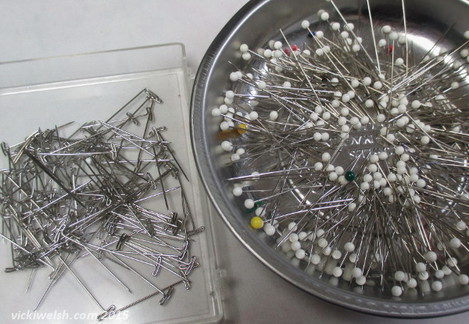
You need lots of really sturdy pins. You know those gigantic quilting pins that you bought but never use because they are like sewing with nails? Those are the ones you want for this. They are going to have a lot of stress on them. T pins work great too.
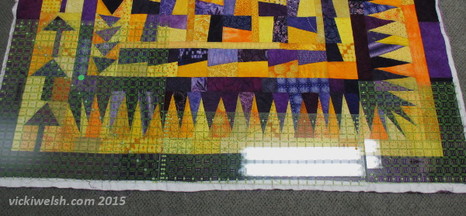
Finally you need your biggest rotary rulers and a measuring tape. You also need to be prepared to take some time. It took me 3 days to dread this task and about an hour and half to actually do it.
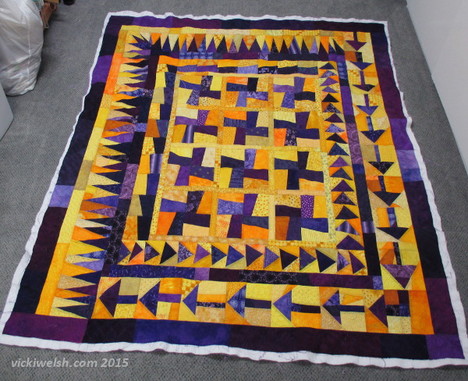
Here it is right out of the washing machine ready for blocking. Blocking is done before the quilt is trimmed. You need that extra backing and batting to insert the pins into and to give you something to tug and pull.
As I was looking at this I felt that it was really important that the center pinwheel section be perfectly square (or more specifically perfectly rectangled). I decided to pin the center first to get it on square and then pin the borders off the center. I don't do that for most of my quilts but these borders are different widths. I know the size of the center blocks so it was best to work off that.
As I was looking at this I felt that it was really important that the center pinwheel section be perfectly square (or more specifically perfectly rectangled). I decided to pin the center first to get it on square and then pin the borders off the center. I don't do that for most of my quilts but these borders are different widths. I know the size of the center blocks so it was best to work off that.
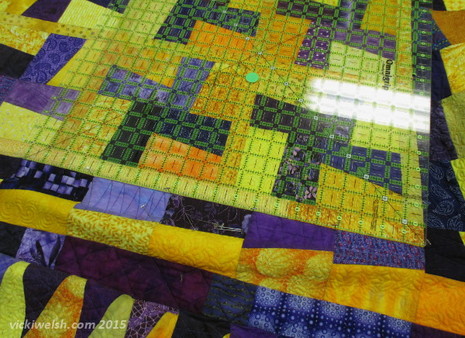
Whether you start in the center or the edge, focus on one edge. I use the edge of the ruler to straighten the seam and the measures on the ruler to stretch the seam and blocks to the right size. The blocks along that edge are 4" so I placed my pins on those seam intersections as I stretched the blocks out to almost 4". There was enough stitching in this quilt that I have to accept that there's some shrinkage. I'm probably not going to ever get it to the original full size and that's fine.
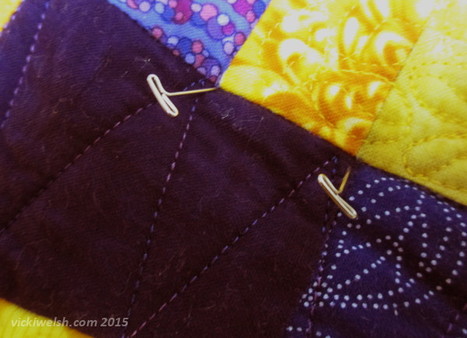
Insert the pins leaning out from the aligned edge. That will hold the edge in place as you pull and pin on the opposite side. If you put the pin in straight it will pull in when you do the other side and then you'll be doing it all over again!
These pins in the center of the quilt will be removed once the outer edges are done so don't worry about pin or stretch "marks".
These pins in the center of the quilt will be removed once the outer edges are done so don't worry about pin or stretch "marks".
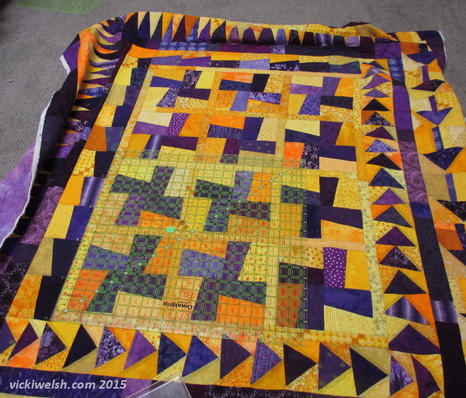
Use the square ruler to square up the corners as you work around the quilt. Here you can see that I've pinned the top and left side. I'm starting the bottom. I'm not worried about how curved the right side looks. It will all get pulled into shape as I work around. This process requires some man-handling so be prepared. If you have a friend to help that's even better.
Knee pads help too.
Knee pads help too.
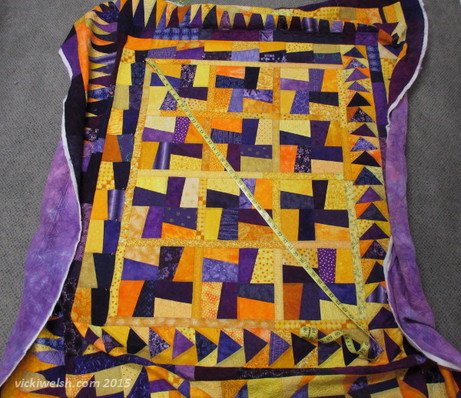
Now comes the most important step of making sure it's square. Measure diagonally in both directions and make sure the measurements are equal. If the measurements aren't the same then go back and figure out where you got off square.
I almost always have to repin some part of it. I can't seem to every do it perfect on the first try.
Next I worked on the outer edges. Once the whole quilt was pinned I removed the pins on the center section. If I left the pins in the center the seam lines in the center might be a little "pointy" where the pins are. Once the whole thing is pinned the ones in the center aren't needed anyway. I pulled out the center pins and smoothed out the seams to make sure everything was straight.
I almost always have to repin some part of it. I can't seem to every do it perfect on the first try.
Next I worked on the outer edges. Once the whole quilt was pinned I removed the pins on the center section. If I left the pins in the center the seam lines in the center might be a little "pointy" where the pins are. Once the whole thing is pinned the ones in the center aren't needed anyway. I pulled out the center pins and smoothed out the seams to make sure everything was straight.
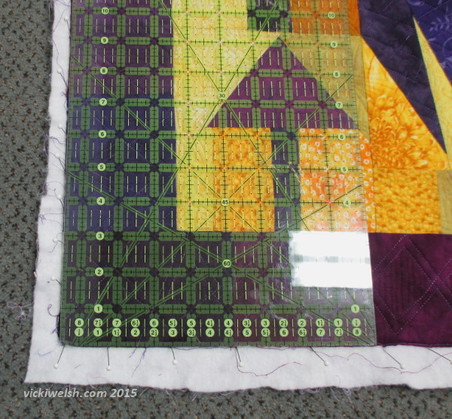
Stretch, measure and pin the border the same as the center. On the outside edge I pin about every 1 to 2 inches.
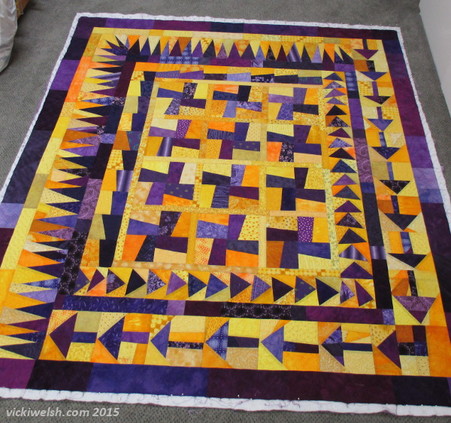
An hour and a half later here it is all pinned. I did have to rework the lower right corner because it wasn't perfectly square the first time. I figured out where the problem was by using my square ruler to check to see which corner border wasn't aligned right. I then pulled out the pins for about 18" along each side, re-pinned, re-measured and had some celebratory chocolate.
Since it's winter and so dry in my house the quilt was completely dry overnight. When I do this in the summer I set up a fan to blow over it to help it dry.
Since it's winter and so dry in my house the quilt was completely dry overnight. When I do this in the summer I set up a fan to blow over it to help it dry.